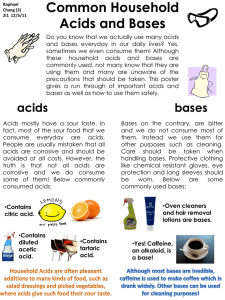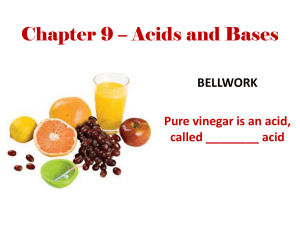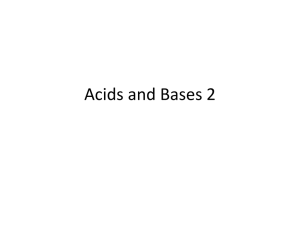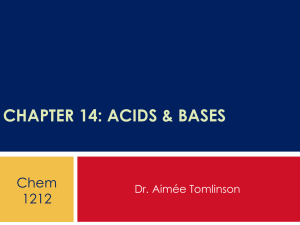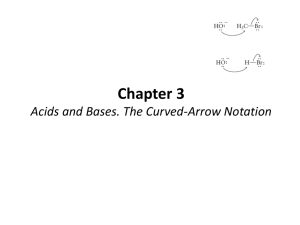Chapter 16 – Acid
advertisement
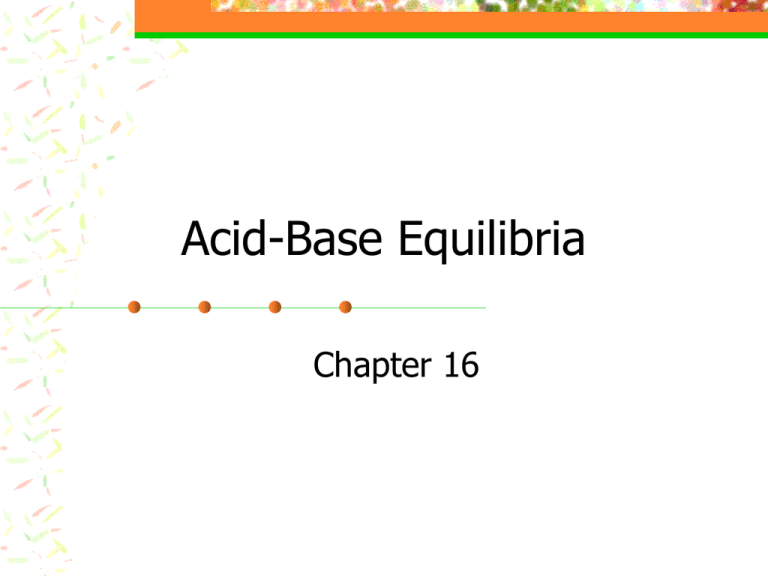
Acid-Base Equilibria Chapter 16 1. Arrhenius Acids and Bases Arrhenius Acid –produce H+ HCl(aq) H+ + Cl Arrhenius Base- produce OH+ NaOH(aq) Na + OH 2. Bronsted-Lowry Acids and Bases B-L acid-base rxns involve a + transfer of a proton (H ) B-L Acid = donates H+ B-L Base = accepts H+ 2. Bronsted-Lowry Acids and Bases HCl + NH3 Cl- + NH4+ HCl + H2O H3O+ + Cl H2O + NH3 NH4+ +OH Amphiprotic – a substance that can be an acid or base 2. Bronsted-Lowry Acids and Bases conjugate acid-base pairs differ only by a proton Sample Exercise 16.1 Identifying Conjugate Acids and Bases (a) What is the conjugate base of each of the following acids: HClO4, H2S, PH4+, HCO3–? (b) What is the conjugate acid of each of the following bases: CN-, SO42–, H2O, HCO3– ? Sample Exercise 16.2 Writing Equations for Proton-Transfer Reactions The hydrogen sulfite ion (HSO3–) is amphiprotic. (a) Write an equation for the reaction of HSO3– with water, in which the ion acts as an acid (b) Write an equation for the reaction of HSO3– with water, in which the ion acts as a base. The Autoionization of Water acid The base ion product of water, Kw=[H3O+][OH-] = 1x10-14 The Autoionization of Water [H+] =[OH-] is neutral [H+] > [OH-] is acidic [H+] < [OH-] is basic Sample Exercise 16.5 Calculating [H+] from [OH-] Calculate the concentration of H+(aq) in (a) a solution in which [OH–] is 0.010 M, (b) a solution in which [OH–] is 1.8 ×10–9 M . 3. Lewis Acids and Bases A lewis acid is an electron pair acceptor A lewis base is an electron pair donor Doesn’t pertain to just H+ 3. Lewis Acids and Bases The pH Scale --- key equations pH = -log[H+] [H+]=10-pH The pH decreases as [H+] increases pOH = -log[OH-] [OH-]=10-pOH pH + pOH = 14 The pH Scale The pH Scale Measuring pH 1. pH meters 2. Titration and Acid-Base Indicators-colored substance that can exist as an acid or base, each having its own color pH meter simulation http://group.chem.iastate.edu/Greenbo we/sections/projectfolder/flashfiles/acid basepH/ph_meter.html Acid-Base Solutions http://phet.colorado.edu/en/simulation/ac id-base-solutions pH Scale http://phet.colorado.edu/en/simulation/p Sample Exercise 16.7 Calculating [H+] from pH A sample of freshly pressed apple juice has a pH of 3.76. Calculate [H+], [OH-], and pOH. Strong Acids and Bases 7 strong acids ??? Strong acids are strong electrolytes and completely ionize in aqueous soln Strong Acids and Bases In aqueous solutions of + strong acids, the [H ] equals the original concentration of acid, calculate the pH from [H+] Sample Exercise 16.8 Calculating the pH of a Strong Acid What is the pH of a 0.040 M solution of HClO4? Strong Acids and Bases Strong bases ??? Strong bases are strong electrolytes and completely ionize in aqueous soln Strong Acids and Bases In aqueous solns of strong bases, the [OH-] depends on the coefficient of the equation Calculate pH from pOH Sample Exercise 16.9 Calculating the pH of a Strong Base What is the pH of (a) a 0.028 M solution of NaOH (b) a 0.0011 M solution of Ca(OH)2? Weak Acids weak acids are partially ionized which is represented as an equilibrium reaction HA + H2O H3O+ + A or HA H+ + A- Weak Acids Ka is the acid-dissociation constant and the magnitude of it indicates the tendency of the acid to ionize. The larger the Ka, the stronger the acid. Weak Acids It is possible to calculate Ka from pH Sample Exercise 16.10 Calculating Ka from Measured pH A student prepared a 0.10 M solution of formic acid (HCOOH) and measured its pH. The pH at 25 ºC was found to be 2.38. Calculate Ka for formic acid at this temperature. Weak Acids Or you can calculate pH from Ka What is the pH of 0.30M -5 HC2H3O2 ? (Ka = 1.8x10 ) Sample Exercise 16.11 Calculating Percent Ionization A 0.10 M solution of formic acid (HCOOH) contains 4.2 × 10–3 M H+(aq) . Calculate the percentage of the acid that is ionized. Warm up: Sample Exercise 16.12 Using Ka to Calculate pH (1) Calculate the pH of a 0.20 M solution of HCN. (Ka = 4.9x10-10.) (2) Calculate the pH of 0.20M HNO3. Sample Exercise 16.13 Using Ka to Calculate Percent Ionization Calculate the percentage of HF molecules ionized in (a) a 0.10 M HF solution, (b) a 0.010 M HF solution Weak Acids Polyprotic Acids have more than one ionizable H atom It is always easier to remove the first proton from a polyprotic acid than the second Ex. H2CO3 Weak Bases Weak bases react with water by taking away a proton forming the conjugate acid of the base and OH- ions + B + H2O BH + OH Weak Bases Types of Weak Bases 1. Neutral substances that have an atom with a nonbonding pair of electrons that can serve as a proton acceptor (substances w/N) 2. Anions of weak acids ; conjugate base of weak acids Weak Bases Weak Bases Sample Exercise 16.15 Using Kb to Calculate OH¯ Calculate the pH of a 0.15 M solution of NH3. Kb = 1.8x 10-5 Relationship between Ka and Kb Ka x Kb=Kw = 1.0 x 10-14 pKa = -logKa pKb=-log Kb pKa + pKb = pKw = 14.00 at 25oC Relationship between Ka and Kb As the strength of an acid increases (larger Ka), the strength of its conjugate base decreases (smaller Kb) Or vice versa Sample Exercise 16.17 Calculating Ka or Kb for a Conjugate Acid-Base Pair Calculate (a) the base-dissociation constant, Kb, for the fluoride ion (F–); (b) the acid dissociation constant, Ka, for the ammonium ion (NH4+). Acid-Base Properties of Salt Solutions salt solutions can be acidic, neutral, or basic the pH of a salt solution can be predicted by the ions that make up the salt Acid-Base Properties of Salt Solutions General Rules 1. An anion that is the conjugate base of a SA will not affect the pH of a solution (Cl-) Acid-Base Properties of Salt Solutions 2. An anion that is the conjugate base of a WA will increase the pH (CN ) Acid-Base Properties of Salt Solutions 3. A cation of a SB will not + affect pH (Na ) Acid-Base Properties of Salt Solutions 4. A cation that is the conjugate acid of a WB will cause a decrease in pH (NH4+) Acid-Base Properties of Salt Solutions 5. With the exception of ions of group 1A and heavier members of 2A, metal ions will cause a decrease in pH Acid-Base Properties of Salt Solutions 6. When a soln contains both the conj. base of a WA and the conj. acid of a WB, the ion with the largest Keq will have the greatest influence on pH Sample Exercise 16.18 Determining Whether Salt Solutions Are Acidic, Basic, or Neutral Determine whether aqueous solutions of each of the following salts will be acidic, basic, or neutral: (a) Ba(CH3COO)2 (b) NH4Cl (c) CH3NH3Br (d) KNO3 (e) Al(ClO4)3. Practice Exercise 16.18 Determining Whether Salt Solutions Are Acidic, Basic, or Neutral In each of the following, indicate which salt in each of the following pairs will form the more acidic (or less basic) 0.010 M solution: (a) NaNO3 or Fe(NO3)3 (b) KBr or KBrO; (c) CH3NH3Cl or BaCl2 (d) NH4NO2 or NH4NO3. Titration simulation http://group.chem.iastate.edu/Greenbo we/sections/projectfolder/flashfiles/stoic hiometry/acid_base.html http://chemilp.net/labTechniques/AcidBaseIdicatorS imulation.htm


